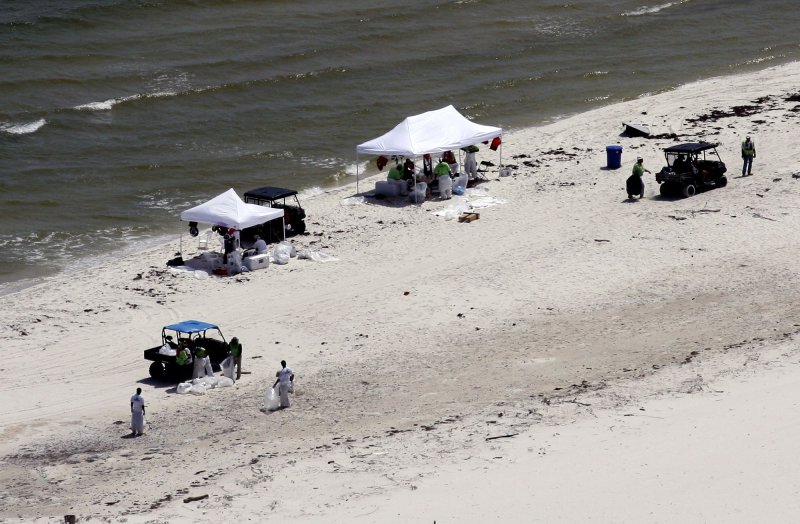1 of 3 | Workers clean up tar balls and residue left on a Mississippi beach by the ongoing Deepwater Horizon oil blowout, July 14, 2010. BP continued its attempts to stem the flow of oil from its rig, which exploded and sank in the Gulf of Mexico in April. UPI/A.J. Sisco.. |
License Photo
VENICE, La., Aug. 11 (UPI) -- Turbulent weather was expected to move over the BP oil well in the Gulf of Mexico Wednesday, forcing the suspension in drilling a relief well, officials said.
The National Hurricane Center in Miami issued a tropical storm warning for the northern gulf coast as the fifth tropical depression of the Atlantic hurricane season formed.
While the crippled oil well has been capped, retired U.S. Coast Guard Adm. Thad Allen, the federal government's point man for the disaster, told CNN problems remain.
"It's a catastrophe," Allen said. "It's a catastrophe for the people of the gulf, and it requires our attention until we get the job done."
The Deepwater Horizon drilling rig leased by BP exploded April 20, killing 11 workers, and sank two days later, spilling millions of barrels of oil into the gulf until a temporary cap contained the spill July 15, and nearly 3,000 barrels of heavy drilling mud and cement drove the well back into the ocean floor last week.
The final step of completing a relief well to permanently seal the blowout from below is expected to be completed by the end of this weekend.
A National Oceanographic and Atmospheric Administration report last week found about 75 percent of the oil spilled between April 20 and July 15 had been collected, dispersed or evaporated.
The spill befouled the area's environment and devastated industries such as tourism and fishing but Allen said some parts of the region are beginning to recover.
"It's starting to happen already, but it's happening incrementally, where the oil is not there now, where we've cleaned it up," he said. "Some beaches are reopening. Fisheries are reopening. And that will happen as soon as we can, either by cleaning up the oil or having the areas tested through NOAA and (the Food and Drug Administration) for seafood safety and so forth."
The well spewed about 53,000 barrels -- 2.3 million gallons -- of oil a day before it was capped. Federal officials estimate as much as 1 million barrels of oil may still lie beneath the gulf's surface.















